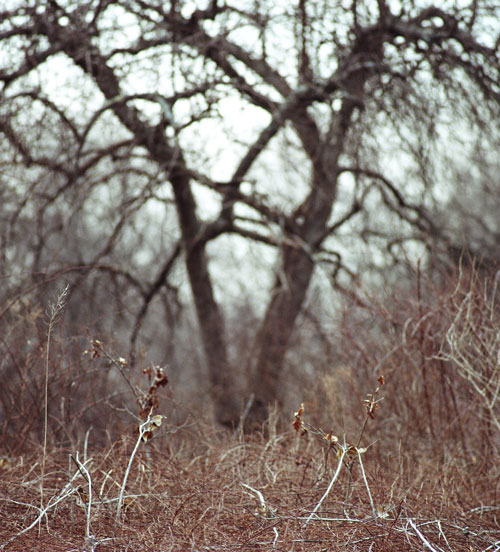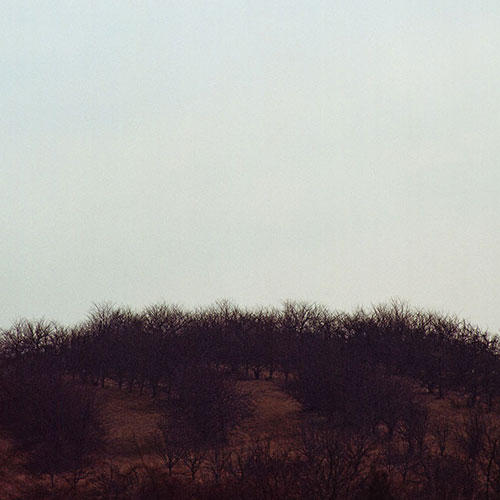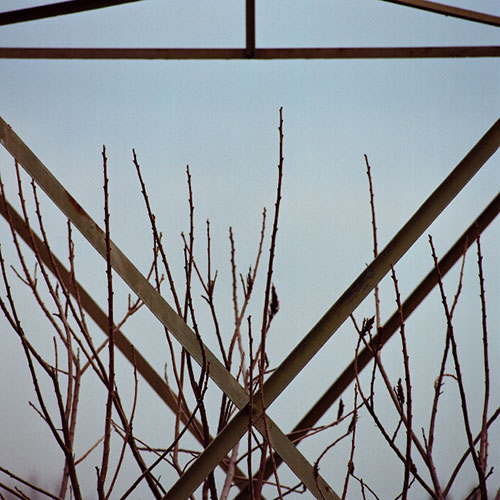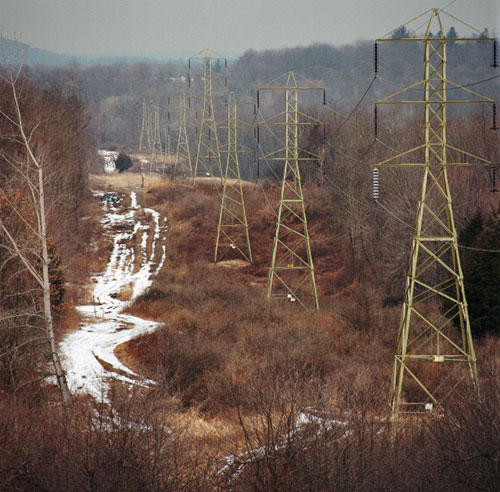I think it would be interesting to be dropped off someplace completely foreign (not knowing where I’m going ahead of time), shoot all day, have my memory of it wiped, and then look at what I shot. Kind of like Winogrand—who waited a few years before processing and printing his exposures so he’d have no distinct memory of making them—plus.
Tag: seeing
Film formats and lens lengths
I’ve got some relatively set preferences for lens lengths, but as I shoot more formats, I’m discovering that I have sometimes very different tastes for them.
For straight 35mm and 6×6, I don’t like anything longer than "normal": 80mm on 6×6 and 45mm on 35mm. (I actually find 50mm a bit long on 135 and prefer the 45mms on my Contax G2 and Hasselblad/Fuji XPan, and 28mm (44.8mm equivalent) on my 1.6x DSLR.) As I’ve written before, long lenses in these formats are pretty much strictly utility items for when I physically can’t get close enough to something. I’d rather go wide, sometimes very wide—I’ve been drooling over the 38mm 6×6 Hasselblad SWC for several years.
On 4×5, I find the "normal"-to-slightly-wide 150mm utterly boring and uninspiring. A Fuji 150/5.6 was the only modern large format lens I had until about two months ago. I did shoot a couple of frames I’m happy with with it, but I found its field of view so blah that I barely bothered to shoot with it at all. I recently bought a 210/5.6, which is getting there, but I was surprised to find that it’s still not long enough! I don’t know whether it’s the 4:5 aspect ratio, or because of the way I see when I have movements available, but my inclination on the format is to go long. (I have to be 2.5-3 feet away from my subject to shoot a head-and-neck shot with the 210mm, which is just too close. I feel like I breathing down their necks.)
It may also be because I’m just beginning with premeditated portraiture, and I’m doing it with this kit… I’m sure I’m in for loads of surprises with that. No interest in going wide so far. I have seen some spectacular LF wide angle landscape photography, but that’s not the kind of landscape pictures I’m interested in making right now.
I also recently picked up a half frame 35mm Olympus Pen FT SLR, which came with a 40mm, close-focussing lens. It’s kind of long on half frame (which has the same aspect ratio as a normal 35mm frame), but it suits me fine. I got a 25mm for it, which I’ve mounted and looked at stuff through, but haven’t felt the need to take a single shot through it yet.
Portraiture with 4×5 is making me want to try 150mm on 6×6, though. I think the only long lens I have for the format, a 350mm, is probably just too much for me.
I’m about to take the plunge into 8×10, which has the same aspect ratio as 4×5, but I’m curious to see if any surprises come out of that. With a viewfinder with four times the area, who knows? It’s bound to change the way I see in one direction or another.
Seeing through vertical viewfinders
I picked up an Olympus Pen FT 35mm SLR at the end of February [2007]. Because it’s half frame, the viewfinder is vertical rather than horizontal, and I was really curious to see if it would affect how I see through it. I’ve been using it as my primary normal-lensed camera for a few months now, and—big shock—it did.
The camera did remind me of how much I don’t like the normal 3:2 aspect ratio of a normal 35mm frame. For me it’s usually in an uninspiring wasteland, being too long for square or 4:5 (which I’ve grown to really like) and too short for a panorama.
Past that, it’s been an interesting experience. The corners of the viewfinder are rounded, which seems like a small thing, but it really affects my mindset when I’m shooting. It reminds me of the prints that were popular when I was a kid, and it gives me a feeling of temporal ambiguity by association.
I still find myself taking just about as many horizontal shots as I used to, but now it’s much more deliberate, and it feels like that’s spilled over into normal viewfinder shooting as well. Seems like one of those things that makes me see better, even if I don’t use it all the time. I highly recommend the vertical viewfinder experience!
Past and presence, another take on wide vs. deep?
I’ve noticed an odd trend lately: most of the people I know who aren’t geeky in any way (aren’t technically inclined, aren’t particularly curious about how things work, and, not wanting to be bothered with technical details, tend to favor point-and-shoot or fully automatic cameras) seem to be really into classifying things. When some of my not-so-geeky friends see a pretty flower or bug, hears a bird song, or whatever, the first thing they do is try to figure out what it "is" (what it’s called, what family it’s in, if it’s native or invasive, etc.). Whereas I think most people would say I’m really geeky in my general approach to life, and I couldn’t possibly care less; to me it’s just a pretty flower, and thinking about classifying it actually interferes with my enjoyment of it. And this seems to be generally true of the geekier people I know, the computer programmers, the food science-inclined cooks, the web site builders… I’m not saying one way is better than the other, but I am more than a little surprised it’s not the other way around.
I, and many of the geeks I know, seem to have low latent inhibition in certain areas. When I look at a lens, I don’t see a single round thing, I see all the elements, the shutter mechanism, the raw materials being mined, processed, and delivered to the factory, the glass being formulated, the lens designer sitting in front of their computer weighing the trade-offs between manufacturing cost & difficulty, size, weight, available materials, and optical quality, and wonder what sort of person they are, if they’re happy, and what they had for breakfast. When I see something I know nothing about, my brain has a much harder time falling down all these rabbit holes at once. Yes, when I look at a pretty flower, it can chew on photosynthesis and cellular reproduction and thigmotropism and all that, but these sorts of natural phenomena get to the "and this is where the magic happens" end of the trail of my real comprehension much more quickly. And when that occurs, when I’m really there with it in the present rather than untangling the hair of its past, I can see the pretty flower for what I believe it to really be: nothing short of a fucking miracle.
And that, of course, completely changes how I’m inclined and able to photograph things. I’m out of the rigidity of literalism and into mystery and—dare I use this awful, wanktastic word—wonder, and there’s a lot more room for personal impression and interpretation to come through—at least there is for me—and those impressions and interpretations are of course vastly different, too. (Again, it’s not a matter of better or worse, just difference.)
I haven’t completely thought this out, I’m just typing through it, but it seems like this ties into the wide vs. deep thing (how your familiarity with a place affects the photographs you make in it) that Colin Jago and Paul Butzi have talked about. I’m not sure how, maybe it’s another kind of wide and deep, or maybe it’s a different axis altogether. I don’t know.
Seeing with long lenses: results
About a week ago, I took a walk in a local park with a Hasselblad 501C/M and a 350mm lens to see if I could get down with long lenses, which I generally don’t like very much (see previous post).
I didn’t feel like I’d done very well at the time, and the film I got back from it yesterday confirms that I was right. As I’m not used to shooting with long lenses, I’m not surprised that I didn’t really feel like I was shooting as myself. At times I felt like I was trying to look through Vicky Slater‘s eyes, but doing a crap job of it.
I should also note that I have a really hard time connecting with landscapes through "normal" (sharp, even coverage) lenses in general.
As promised, here are some of the results, shot on the new Kodak Portra 400NC-2.

Close to something, maybe, but no cigar.

These are the lab’s proof scans. I think this shot has the most potential, if I can pull more detail out of the trees when I re-scan it. I’ll reserve judgment until I see it.
It feels kind of pretty, in a really classically conservative way. Which I think may be my problem with long lenses and "clean" landscapes in general: when I like them, they usually feel very reserved and forced into a box. I may find something aesthetically pretty in what I’ve shot after the fact, but it’s not how I generally see, especially not landscapes.

This isn’t great, but I suppose it’s passable as geometric masturbation, which is a type of photo I love to make but don’t think necessarily makes for compelling viewing unless it’s done extremely well. Kind of like playing a 20 minute jam with a band: really fun for the people playing, but not something you’d inflict on anybody else.

Depth of field test with a long view/burn frame at the end of the roll. Safe crap.
Seeing with long lenses
Yesterday started out beautifully. It was almost 80°F in the sun, which was a welcome change from the cold New York winter, and I went to Peach Hill Park, which is an old apple orchard. I haven’t fixed the light leak in my one particular copy of a Spartus that’s my favorite landscape camera (it’s not the cool kind of leak, it washes out the whole frame), and I didn’t have time to load film holders, so 4×5 was out, too. Instead, I reached for my Hasselblad 501C/M and noticed the 350mm lens that I’d only ever shot maybe 3 frames with. (For the record, I inherited both from my father; I’m not in the habit of buying Hasselblad lenses only to leave them in the closet for years.)
I’m not a big fan of long lenses. Not that I hate them or anything, but they don’t do much for me unless I physically can’t get close enough to what I want to shoot, like at a show or a wedding. I tend to go for normal to moderately wide, even finding the standard "normal" 50mm on 35mm film to be a touch long. 350mm is generally outside of my visual consciousness. I figured I’d give myself a challenge and took only the one camera and lens to see what I could learn.
I walked around and shot for about an hour and half and packed it in when it started raining. I took my time, shooting only 24 exposures, framing probably five shots for every one I took, really trying to get a feel for what this thing lends itself to. I think I failed. Other than being unweidly—the camera, lens, and hood together are longer than my forearm—I had no grand epiphanies. I don’t feel like I even got my foot in the door, but I’ll keep at it for a bit longer. For better or worse, it sure is different.
UPDATE: photos are here.